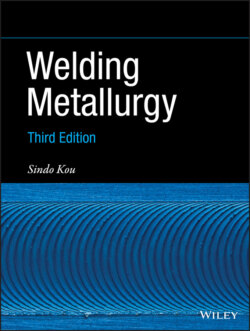Читать книгу Welding Metallurgy - Sindo Kou - Страница 91
3.1.2 Flat‐End Electrode
ОглавлениеWith a flat‐end electrode, on the other hand, there is no longer a sharp electrode tip to act as a fixed cathode spot, where the electric current enters the electrode. Consequently, the cathode spot moves around rather randomly and quickly in the flat electrode end. The time‐averaged diameter of the area covered by the moving spot can be considered as the effective cathode spot size. Without a conical surface at the electrode end, the resultant Lorentz force is still inward and downward, but the downward component is reduced as illustrated in Figure 3.5a. Consequently, the resultant arc can be expected to be more constricted, as shown in Figure 3.5b.
Figure 3.5 Arc produced by a tungsten electrode with a flat end: (a) Lorentz force (F); (b) fluid flow.
Figure 3.6 (left) shows the current density distribution in a 2 mm long, 200 A arc produced by a 3.2 mm diameter electrode with a flat end and a 2.4 mm‐diameter cathode spot. The Lorentz force, shown in Figure 3.6 (right), is less downward pointing than that in the case of a 60°‐angle electrode (Figure 3.3). As shown in Figure 3.7, the isotherms are not pushed outward as much, and the resultant arc is thus more constricted.
Figure 3.6 Current‐density field (left) and Lorentz force (right) in an arc produced by a tungsten electrode with a flat end.
Source: Tsai and Kou [1]. © Elsevier.
Figure 3.7 Velocity and temperature fields in an arc produced by a tungsten electrode with a flat end. The isotherms from right to left are 11 000, 13 000, 15 000, 17 000, 19 000 and 21 000 K.
Source: Modified from Tsai and Kou [1]. © Elsevier.
